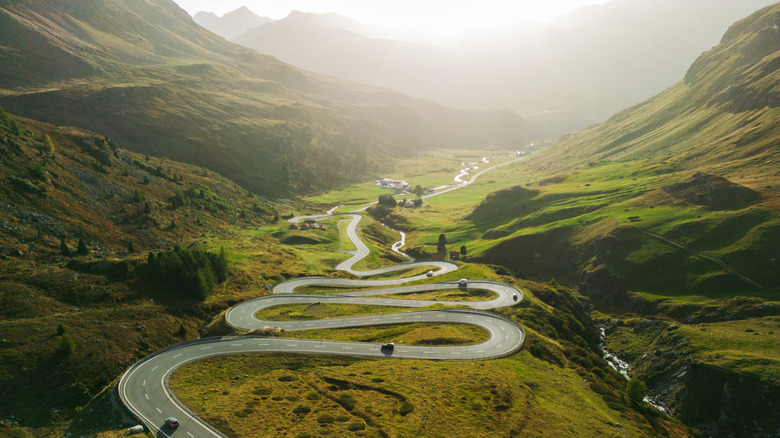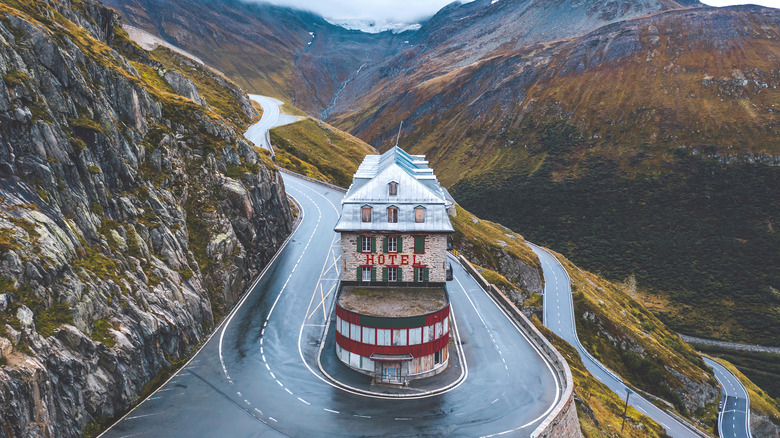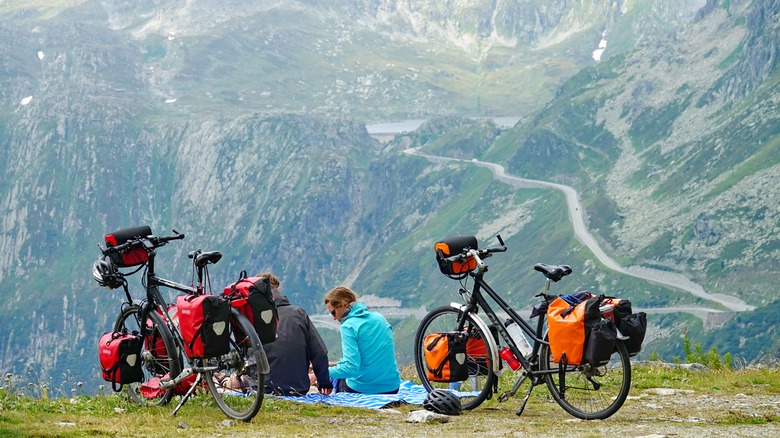This Iconic Mountain Pass Is One Of The Most Breathtaking Roads In All Of Europe
Frankly, pictures of the Furka Pass in Switzerland don't look real. The two-lane highway snakes its way up a mountain, heading one way for 500 yards or so before making an abrupt 180-degree turn and going the opposite way — again and again, over the course of 48 hairpin bends. If you haven't spent much time on alpine highways, the endless zigzags look so improbable, so dizzying, that you may assume some prankster was messing around with AI images. Yet the Furka Pass is quite real, and in certain seasons, this breakneck route is the fastest way to get from the town of Gletsch (5,787 feet above sea level) to the town of Andermatt (6,978 feet).
Swiss villagers have traversed the Furka Pass since the Middle Ages, and a rugged version of the current road opened in 1867. The switchbacks ensure that the road is never too steep to drive, but most first-time visitors will bite their nails as they curve their way up and down the 20-mile stretch. Everywhere you look, mountains and valleys sprawl around you. The pass also skirts the Rhône Glacier, which is famous for a blue-tinted tunnel that burrows through the ice. The high elevation does have an impact on road conditions; although mid-winter is the best time of year to go skiing in Switzerland, the Furka Pass is routinely closed between November and May, due to snow cover.
Furka Pass: Switzlerland's most thrilling motorway
One of the most famous scenes in the James Bond franchise takes place in "Goldfinger" (1964), in which 007 drives an Aston Martin DB5 through the Alps in pursuit of the eponymous villain. Millions of viewers were treated to the twisting roadway and spectacular views of the Furka Pass, back when some of the route was composed of gravel. They also got a glimpse of the Hotel Belvédère, a historic stone building that dates back to the 19th century and hosted a wide range of guests, from Pope John XXIII to Sean Connery (when he wasn't filming high-speed chases). Unfortunately, the hotel and restaurant both closed in 2016, but it remains one of the road's most beloved landmarks, and drivers regularly stop to take pictures.
Most drivers take the pass pretty slow, thanks to an 80 kph (50 mph) speed limit. Take heed, because the road has little shoulder and no guardrails, and drivers are vulnerable to falling rocks. Luckily, even the highest elevation on the Furka Pass is pretty forgiving, by Swiss standards; ascend any higher, and tourists in Switzerland may underestimate this dangerous sickness.
Bike, bus, or train the Furka Pass
Such picturesque landscapes aren't just for drivers, though. Buses regularly make their way through the Furka Pass, so backpackers can leave the steering to a seasoned driver. Motorcyclists love to wind their way through the pass, and the thigh-burning climb of 3,494 feet has attracted a steady stream of cyclists as well. Anyone traveling on two wheels should be especially cautious of wet or icy roads; this part of Switzerland receives nearly 80 inches of rain each year, and weather can critically affect road conditions.
The Furka Pass isn't for everybody. If you're an inexperienced driver or afraid of heights, these dizzying turns can induce vertigo — and of course no one can access the pass at the height of winter. An alternative is to take the Furka Cogwheel Steam Railway, a narrow-gauge train that chugs its way through tunnels and bypasses the highway altogether. The line's locomotives harken back to the days of steam engines, and some engines are actually a century old. The train doesn't take you from Gletsch to Andermatt, but it does connect the same two counties across 11.5 miles, from the town of Oberwald to the town of Realp. If you're driving, you can ride the special car-carrier train between these same two stations, which takes only 20 minutes and carries you (and your ride) through remote mountain tunnels. If you're looking to escape typical tourist spots, discover this outdoorsy Swiss paradise that's only an 85-minute drive past Gletsch.


